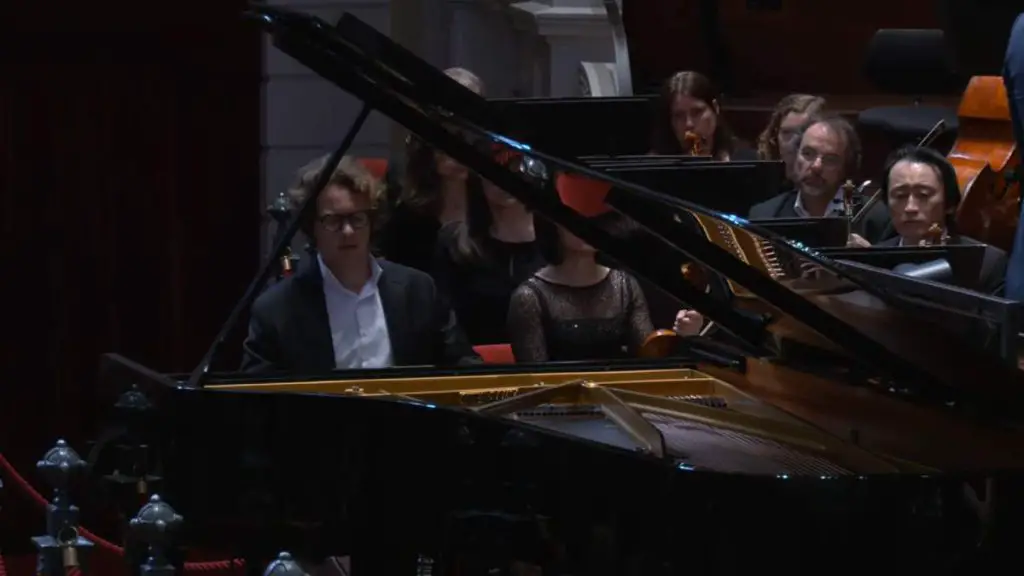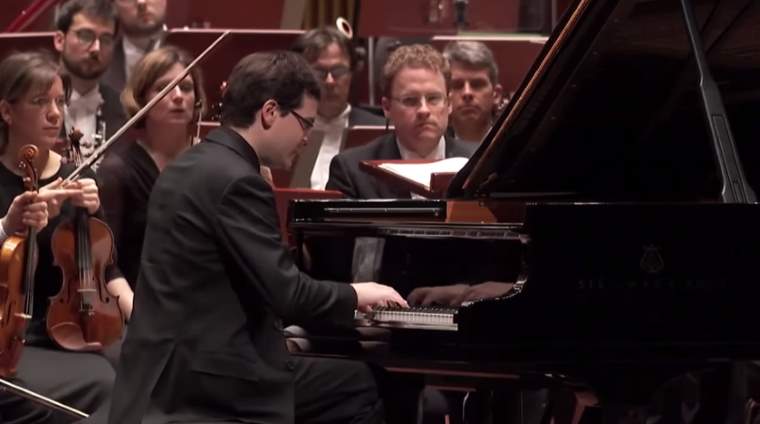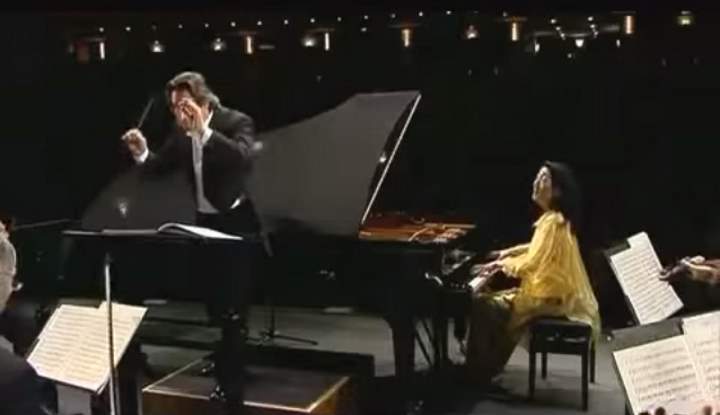Accompanied by the Philharmonie Zuidnederland (South Netherlands Philharmonic), the Dutch classical pianist Hannes Minnaar performs Wolfgang Amadeus Mozart’s Piano Concerto No. 25 in C major, K. 503. Conductor: Duncan Ward. Recorded on May 28, 2023, at the Het Concertgebouw in Amsterdam.
Mozart’s Piano Concerto No. 25
Mozart’s Piano Concerto No. 25 in C Major, K. 503 is one of his grandest and most majestic works in the piano concerto genre. Composed in 1786, following the success of his opera, “Le Nozze di Figaro” (The Marriage of Figaro), this concerto is often viewed as a culmination of his mature concerto style, showcasing a balance of elegance, complexity, and emotional depth. Its composition came at a time when Mozart was at the height of his creativity, and this concerto reflects the confidence and mastery he had achieved.
The key of C major, often associated with grandeur and strength, sets the tone for the concerto’s broad and stately character. Unlike some of his more intimate or lighthearted concertos, Piano Concerto No. 25 exudes a sense of grandeur that aligns it more closely with his symphonic works. The concerto is richly orchestrated, featuring not only the usual strings and winds but also trumpets and timpani, adding to its bold and expansive sound. So, it is widely considered one of the greatest examples of the symphonic spirit in Mozart’s compositions.
The dialogue between the piano and orchestra is particularly sophisticated, with the piano often leading the way with both grace and virtuosity, while the orchestra supports and contrasts with moments of dramatic intensity.
Throughout the concerto, Mozart’s mastery of thematic development is on full display. The musical ideas are not just introduced but are expanded upon and transformed, creating a sense of growth and evolution as the work progresses. The concerto transitions between moments of brilliance and introspection, seamlessly blending lyrical beauty with virtuosic displays.
Despite its imposing scale, the concerto retains Mozart’s signature elegance and clarity, never overwhelming the listener but rather drawing them into its richly textured world. Piano Concerto No. 25 is often seen as a fitting close to Mozart’s great series of piano concertos, reflecting the maturity, depth, and grandeur of his later works. It remains a staple in the concert repertoire, admired for its architectural beauty and emotional resonance.
Mozart’s Piano Concerto No. 25, along with his other piano concertos, helped to define the genre, and they remain a critical part of the repertoire for concert pianists today. Its thematic complexity, structural sophistication, and emotional depth mark it as a landmark in Mozart’s body of work.
Movements
1. Allegro maestoso
The first movement of Mozart’s Piano Concerto No. 25, marked as Allegro maestoso, is a marvel of musical sophistication, and it’s one of the most expansive of all of Mozart’s concertos.
This movement, richly orchestrated and full of majestic themes, employs a grand scale that suggests a symphonic character. It opens with a powerful introduction by the orchestra, establishing the home key of C major and introducing the main themes of the movement. After the orchestra’s exposition, the solo piano makes its entrance, not only repeating the themes introduced by the orchestra but also adding new ones, and further developing them.
The Allegro maestoso is characterized by its intricate development of motifs and the elaborate interaction between the piano and the orchestra. The extensive orchestration adds to the broad, almost regal, atmosphere of this movement.
It is also noteworthy for the balance Mozart achieved between the soloist and orchestra, a hallmark of his mature concertos. Instead of merely accompanying the soloist or vice versa, the piano and orchestra engage in a dialogue, each adding depth and intricacy to the themes.
This movement exhibits Mozart’s skill in seamlessly blending the solo piano into the orchestral texture, creating an integrated musical conversation that is a defining feature of the concerto genre.
2. Andante
The second movement of Mozart’s Piano Concerto No. 25, marked as Andante, provides a profound contrast to the grandeur of the first movement. This piece transitions into a more serene and intimate space, offering an emotive and deeply expressive journey for the listener.
This movement is composed in F major, which creates a warm and rich sound in contrast to the vibrant C major of the previous movement. The slower tempo, as indicated by ‘Andante,’ along with the movement’s more introspective nature, adds to the overall sense of tranquility and reflection.
The music unfolds at a moderate pace, with the piano taking the lead, introducing the melody before it is subsequently developed and embellished. The dialogue between the piano and the orchestra remains central in this movement, but it is more subtle and delicate compared to the vigorous interaction in the first movement.
The Andante of the piece is a testament to Mozart’s ability to create music that can transport listeners into a realm of peace and beauty, offering a respite from the intensity of the opening Allegro maestoso. It showcases Mozart’s masterful ability to control mood and emotional expression, contributing to the overall depth and diversity of the concerto.
3. Allegretto
The finale of Mozart’s Piano Concerto No. 25 is an Allegretto, bringing the concerto to a vibrant and energetic conclusion. It harks back to the vigor and majesty of the first movement, but with a distinct playful and lighter spirit that gives the finale its unique character.
This movement is composed as a rondo, a musical form characterized by the return of a principal theme, which alternates with contrasting sections. The movement’s main theme is introduced by the piano before being taken up by the orchestra. This theme is lively and rhythmic, with an almost dance-like quality.
The playful dialogue between the soloist and the orchestra continues, similar to the previous movements. However, the piano now often leads, with the orchestra responding. This engaging interplay creates a dynamic texture, leading to an invigorating musical experience.
Mozart’s use of dynamic contrast, his manipulation of the principal theme, and the nuanced interaction between piano and orchestra make this movement an exuberant end to the concerto. The joyful, spirited character of the Allegretto serves as a perfect counterpoint to the introspective Andante and the grand Allegro maestoso, showcasing Mozart’s genius in creating a well-rounded musical narrative.
Hannes Minnaar
Minnaar first stepped into the spotlight as the runner-up at the Geneva International Music Competition in 2008, and later, the third-place winner at the Queen Elisabeth Competition in 2010. His unique interpretation and performance style is deeply rooted in the teachings of his mentors, Jan Wijn, Jacques van Oortmerssen, and Ferenc Rados, supplemented by masterclasses from Menahem Pressler.
In his journey, Minnaar has had the opportunity to collaborate with esteemed conductors such as Herbert Blomstedt, Antony Hermus, Xian Zhang, and the late Jirí Belohlávek. In 2011, he was recognized as a Borletti-Buitoni Trust Fellow and later received the prestigious Dutch Music Award in 2016 – the highest honor in classical music from the Dutch Ministry of Culture.

During the global pandemic’s enforced hiatus, Minnaar turned to Bach’s Goldberg Variations for comfort and inspiration. He embarked on a concert tour across Holland’s magnificent churches and recorded this iconic piece. Minnaar also recorded Nox, a recital disc centered on a nighttime theme (comprising pieces by Schumann, Ravel, and a commissioned cycle by Robert Zuidam) that garnered rave reviews in the Dutch press.
A central part of Minnaar’s musical identity is his collaboration with the Van Baerle Trio, co-founded with violinist Maria Milstein and cellist Gideon den Herder in 2004. Recognized as ECHO Rising Stars in 2013-14, courtesy of a nomination from Amsterdam’s Concertgebouw, the trio has released all of Beethoven’s works for piano trio, including the Triple Concerto, performed with the Residentie Orchestra under Jan Willem de Vriend’s direction.
Sources
- Piano Concerto No. 25 (Mozart) on Wikipedia
- Hannes Minnaar’s official website
- Chopin: Scherzo No. 3 [İlyun Bürkev] - September 14, 2024
- César Franck: Violin Sonata [Argerich, Capuçon] - September 8, 2024
- Beethoven: Piano Sonata No. 23 “Appassionata” [Anna Fedorova] - September 7, 2024

